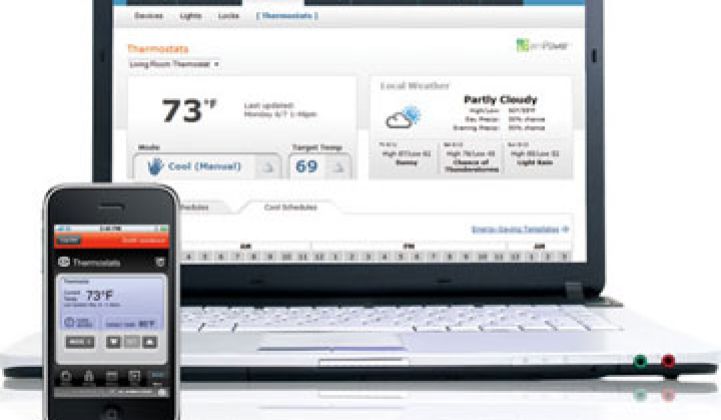One month ago, Alarm.com, the connected home and security company, announced it had reached its one-millionth-customer milestone.
To keep the momentum going, Alarm.com just raised $136 million, according to a filing with the U.S. Securities and Exchange Commission.
The equity round will likely be used to continue its growth, which goes far beyond the alarm business. The company did not offer details on the investment.
Two years ago, when Alarm.com was in about 300,000 homes, it announced that it was moving into home energy management. Now, its emPower application allows users to remotely connect to a thermostat or lights, and its latest service allows location-based settings so a smartphone can automatically trigger settings in your home. If you’re 10 miles away, for instance, your thermostat can know to turn itself up or down, without you having to go into the app and change the settings manually. The company claims that many of its customers choose a full suite of services, rather than just security.
Alarm.com uses a GSM-cellular based network for communications and Z-Wave in the home. Earlier this year, Alarm.com announced a partnership with Verizon Wireless to leverage that company's network for its communications.
Alarm.com is also a key partner of Vivint, another of the country’s larger home alarm system companies. Vivint recently expanded into third-party-financed residential solar. Earlier this year, Vivint lined up $75 million for its solar business. Vivint has also integrated Tendril’s cloud platform into its home automation service.
In many ways, alarm companies have been the success story in the connected home and energy management space. They already have what utilities and others lack -- a solid sales strategy and no qualms about walking into people’s homes and setting up services. The move into connected energy is just an extension of what they’re already doing: providing comfort and convenience for homeowners.
Even if Alarm.com doesn’t move into solar as Vivint is doing, the equity round will likely be used to expand all of its services, including energy offerings. Another revenue source for Alarm.com and other companies is to then go to utilities and let them know that they have tens of thousands of customers in the territory who could then be offered dynamic pricing or demand response programs -- a far more attractive option to many utilities rather than building and maintaining their own programs.
When it comes to courting utilities with a built-in customer base, the competition is coming from telecoms, big-box stores and established thermostat companies, which also have connected home offerings. Radio Thermostat of America’s Filtrete thermostat runs on EnergyHub’s platform. Lowe’s recently announced home automation services starting at $179 built on AlertMe’s platform. Verizon also has its own home automation offering, which communicates via Z-Wave. Additionally, EcoFactor is working with Comcast, and iControl is partnered with Time Warner Cable.
For most of these companies, the energy piece is not the big seller; rather, it is an add-on that can help with customer retention or bring in a few extra dollars per month on top of extra services. If companies like Alarm.com, Lowe’s and Comcast can successfully sell energy services to existing customers, expect to see utilities try to leverage those existing relationships sooner rather than later.



